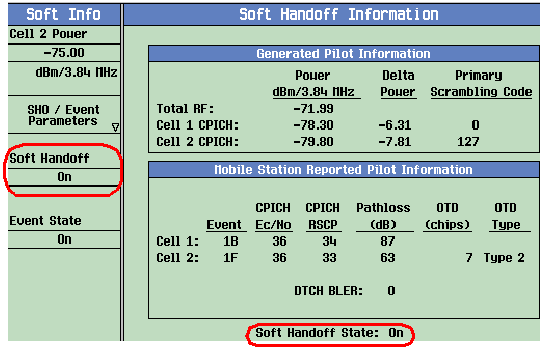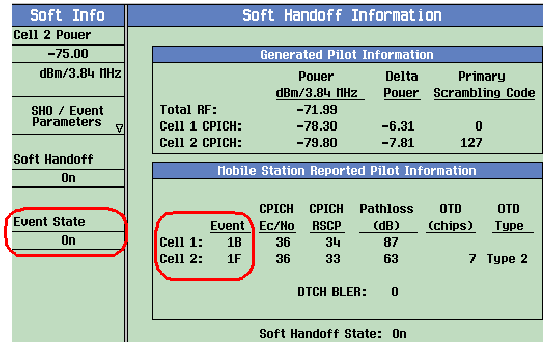Soft Handover
Last updated: January 16, 2009
This section is only applicable to the lab application.
- Cell 2 Overview
- Soft Handover Overview
- Mobile Station Reported Pilot Information
- Enabling Soft Handover
- Soft Handover State
- Loopback BER and BLER Testing in Soft Handover
- Event Reporting
Cell 2 Overview
The lab application includes two sectors, cell 1 and cell 2. Cell 1 is a full sector, supporting all call processing functionality available in the test set. Cell 2 is provided to allow the test set to perform a soft handover. Cell 2 alone can not be used for call processing events, such as establishing a call or handing off to a new frequency. Cell 2 can only be used in conjunction with cell 1 to test the UE's soft handover capability. The table below summarizes the features of cell 1 and cell 2, and indicates if the features are user-settable.
| Feature | Cell 1 | Cell 2 | |
|---|---|---|---|
| DL Channel | User-settable (see Downlink Channel (UARFCN) ) | Equals cell 1 setting | |
| Level | User-settable | User-settable (see CALL:CELL2:CPIChannel ). | |
| P-CCPCH/SCH | Level | User-settable | User-settable (see CALL:CELL2:CCPChannel ). |
| S-CCPCH | Channelization Code | User-settable | No S-CCPCH |
| Level | User-settable | No S-CCPCH | |
| PICH | Channelization Code | User-settable | No PICH |
| Level | User-settable | No PICH | |
| AICH | Channelization Code | User-settable | No AICH |
| Level | User-settable | No AICH | |
| Channelization Code | User-settable | Equals cell 1 setting | |
| Level | User-settable | User-settable (see CALL:CELL2:DPCHannel ). | |
| Composite OCNS | 16 channels (see Orthogonal Channel Noise Simulator (OCNS) ) | 1 channel at OVSF [128,2] (see CALL:CELL2:OCNSource ) | |
| Primary Scrambling Code | User-settable | User-settable (see CALL:CELL2:SCODe ). | |
| Cell Power | User-settable | User-settable. Cell 2 power must be within 10 dB of cell 1 power. Cell 2 is turned off if cell 1 is turned off. (see CALL:CELL2:POWer ) | |
| Closed Loop Power Control | User-settable: All Up, All Down, Alternating, 10 Up/10 Down, Active, Single Up, Single Down (see Uplink Closed Loop Power Control Parameters and UE Target Power ). | User-settable: All Up, All Down, Alternating, 10 Up/10 Down, Active. When set to "Active," the TPC bits transmitted are the same as those transmitted by cell 1 (see Cell 2 UL CL Power Ctrl Mode and CALL:CELL2:CLPControl ). | |
| Cell 2 Time Offset | You can specify a time offset which offsets the cell 2 signal in time relative to the cell 1 signal (see How Do I Configure Cell 2? and CALL:CELL2:TOFFset ). The test set can then order the UE to measure and report the SFN-SFN Observed Time Difference (OTD) . | ||
See How Do I Configure Cell 2? for more information about configuring cell 2 from the front panel. See Downlink Channel Codes and Levels for more information about cell 1 channelization codes and levels.
The test set's total RF output power is a combination of the power of cell 1, cell 2 and AWGN power:
Total RF Power (dBm/3.84 MHz) = [Cell 1 Power + Cell 2 Power + AWGN Power] (dBm/3.84 MHz)
(see
Cell Power and AWGN Power
for more information about cell power and AWGN power).
Soft Handover Overview
The soft handover functionality is accessible through the
Soft Handover Information
screen (select
Handovers
(
F5
) on the
Call Control
menu, then
Soft Handover Info
(
F4
).)
Generated Pilot Information
The
Generated Pilot Information
window reports:
-
Total RF Power -
Cell 1 CPICH Power(Cell Power + CPICH Level (or Cell 1 Connected CPICH Level)) -
Cell 2 CPICH Power(Cell 2 Power + Cell 2 CPICH Level) -
Delta Power(the difference between the CPICH and Total RF Power) -
Primary Scrambling Code
See Cell Power and AWGN Power , Downlink Channel Codes and Levels and CALL:STATus .

Mobile Station Reported Pilot Information
When a non-HSDPA connection is established between the test set and UE, you may request measurement results from the UE, including
CPICH RSCP
,
CPICH Ec/No
,
Pathloss
,
OTD
,
OTD Type
and
DTCH BLER
(see
Cell 1/Cell 2 UE Reported Measurements
). When you request UE reported measurement results, results for CPICH RSCP, CPICH Ec/No and Pathloss are returned for both cell 1 and cell 2 (if cell 2 is set to a non-zero power level). If you have enabled soft handover (see
Enabling Soft Handover
), the DTCH BLER Report result includes both cell 1 and cell 2 (there is only one DTCH in soft handover because soft combining of the two radio links in the UE occurs before the point where the DTCH is extracted and BLER is calculated).
Enabling Soft Handover
After establishing a non-HSDPA call between the test set's cell 1 and the UE, and configuring cell 2 (power, primary scrambling code, time offset, etc., see Cell 2 Overview ), you may turn soft handover on (see How Do I Perform a Soft Handover? and CALL:SHANdoff:ENABle ). This orders the UE to try to demodulate the signal from cell 2. Soft handover is not supported while on a CELL_FACH connection (see RB Test Mode RRC State Setting ) or while on an HSDPA connection.
Soft handover is supported for HSUPA connections but only to simulate a network scenario for when a UE performs a soft handover with cell 2 but the HSUPA channels remain confined to the cell 1 (serving cell). When an HSUPA call is established between the test set's cell 1 and the UE and you turn soft handover on, the DPCH is instructed to soft handover to cell 2 while the HSUPA channels remain confined to cell 1.

Soft Handover State
If the soft handover was successful (the UE responded correctly to the Active Set Update procedure), then a status of
On
is displayed for
Soft Handover State
(see
CALL:STATus:SHANdoff:STATe?
).
Loopback BER and BLER Testing in Soft Handover
You can test Loopback BER and BLER while in soft handover (see How Do I Perform a Soft Handover? , Loopback Bit Error Ratio (BER) Measurement Description and Block Error Ratio (BLER) Measurement Description ). When soft handover is not enabled, as you increase cell 2 power, you will see an increase in BER/BLER (because cell 2 acts as an interferer). When you enable soft handover, the BER/BLER result should improve, as the UE is then able to soft combine the signals from both cells. (If cell 2 level is too high, the messaging to order a soft handover may not be properly received by the UE and an error will be posted. If this is the case, simply decrease cell 2 power, enable soft handover, then return cell 2 to its previous level).
Event Reporting
The soft handover functionality present in the test set also allows you to enable/disable event reporting (by turning
Event State
on and off), and to configure event parameters (such as
Event 1a State
,
R
1a
etc.).

When event reporting is enabled (non-HSDPA connections only), the UE reports to the test set when an event occurs (if you have enabled that event by turning its state on. For example: if you have set
Event 1a State
to
On
, then the UE will report when a 1a event occurs). You can query the most recent event reported by the UE using the
CALL:STATus:SHANdoff:EVENt?
query, and which cell caused the event using the
CALL:STATus:SHANdoff:EVENt:CELLid?
query.
When you turn
Event State
on (enable event reporting), the test set sends a Measurement Control message to the UE with the following user-settable event information:
- 1a (A Primary CPICH enters the Reporting Range): Event 1a State, W, R 1a , H 1a
- 1b (A Primary CPICH leaves the Reporting Range): Event 1b State, W, R 1b , H 1b
- 1c (A Non-active Primary CPICH becomes better than an active Primary CPICH): Event 1c State, H 1c
- 1d (Change of best cell): Event 1d State, H 1d
- 1e (A Primary CPICH becomes better than an absolute threshold): Event 1e State, T 1e , H 1e
- 1f (A Primary CPICH becomes worse than an absolute threshold): Event 1f State, T 1f , H 1f
(see How Do I Configure and Enable (Start) Event Reporting? and CALL:SHANdoff )
Send Event Config
(
F5
when viewing the
SHO/Event Parameters
menu with
Event State
on) or by toggling
Event State
off and on.The Measurement Control message sent by the test set orders the UE to use the RSCP measurement result to determine whether an event has occurred. When an event occurs, the UE reports the requested MS reported measurement results - CPICH Ec/No, CPICH RSCP, Pathloss and/or DTCH BLER Report (see Mobile Station Reported Pilot Information ).
Related Topics
Manual Operation: How Do I Configure Cell 2?
Manual Operation: How Do I Configure and Enable (Start) Event Reporting?
Manual Operation: How Do I Perform a Soft Handover?